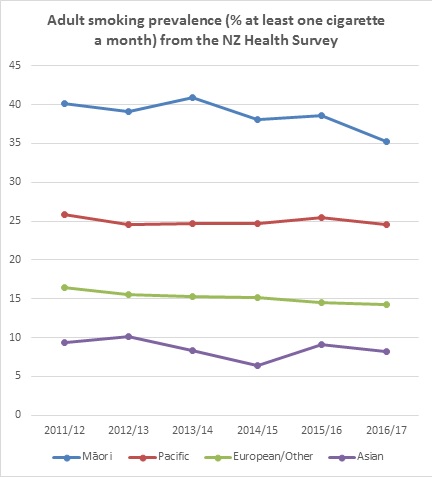References
- Ball J, Stanley J, Wilson N, Blakely T, Edwards R. Smoking prevalence in New Zealand from 1996-2015: a critical review of national data sources to inform progress toward the Smokefree 2025 goal. N Z Med J. 2016;129(1439):11-22.
- Blakely T, Cobiac LJ, Cleghorn CL, Pearson AL, van der Deen FS, Kvizhinadze G et al. Health, health inequality, and cost impacts of annual increases in tobacco tax: Multistate life table modeling in New Zealand. PLoS Med. 2015;12(7):e1001856. [Correction at: http://journals.plos.org/plosmedicine/article?id=1001810.1001371/journal.pmed.1002211].
- van der Deen FS, Wilson N, Blakely T. A continuation of 10% annual tobacco tax increases until 2020: Modelling results for smoking prevalence by sex and ethnicity. N Z Med J. 2016;129(1441):94-97.
- van der Deen FS, Wilson N, Cleghorn CL, Kvizhinadze G, Cobiac LJ, Nghiem N et al. Impact of five tobacco endgame strategies on future smoking prevalence, population health and health system costs: two modelling studies to inform the tobacco endgame. Tob Control. 2017;(E-publication 24 June).
- Thomson G, Wilson N. Local and regional smokefree and tobacco-free action in New Zealand: highlights and directions. N Z Med J. 2017;130(1462):89-101.
- van der Deen FS, Pearson AL, Wilson N. Ending the sale of cigarettes at US pharmacies. JAMA. 2014;312(5):559.
- Nghiem N, Cleghorn CL, Leung W, Nair N, van der Deen FS, Blakely T et al. A national quitline service and its promotion in the mass media: modelling the health gain, health equity and cost-utility. Tob Control. 2017;(E-publication 24 July).
- Edwards R, Hoek J, van der Deen F. Smokefree 2025–use of mass media in New Zealand lacks alignment with evidence and needs. Aust N Z J Public Health. 2014;38(4):395-396.
- Zhu SH, Zhuang YL, Wong S, Cummins SE, Tedeschi GJ. E-cigarette use and associated changes in population smoking cessation: evidence from US current population surveys. BMJ. 2017;358:j3262.
- Ikeda T, Cobiac L, Wilson N, Carter K, Blakely T. What will it take to get to under 5% smoking prevalence by 2025? Modelling in a country with a smokefree goal. Tob Control. 2015;24(2):139-145.
- Cobiac LJ, Ikeda T, Nghiem N, Blakely T, Wilson N. Modelling the implications of regular increases in tobacco taxation in the tobacco endgame. Tob Control. 2015;24(e2):e154-160.
- van der Deen FS, Ikeda T, Cobiac L, Wilson N, Blakely T. Projecting future smoking prevalence to 2025 and beyond in New Zealand using smoking prevalence data from the 2013 Census. N Z Med J. 2014;127(1406):71-79.
- Thornley L, Edwards R, Waa A, Thomson G: Achieving Smokefree Aotearoa by 2025. University of Otago, ASPIRE 2025, Quitline, Hapai Te Hauora, 2017. https://aspire2025.files.wordpress.com/2017/08/asap-main-report-for-web2.pdf.
- Delany L, Thomson G, Wilson N, Edwards R. Key design features of a new smokefree law to help achieve the Smokefree Aotearoa. N Z Med J. 2016;129(1439):68-76.
About the Briefing
Public health expert commentary and analysis on the challenges facing Aotearoa New Zealand and evidence-based solutions.
Subscribe

Public Health Expert Briefing
Get the latest insights from the public health research community delivered straight to your inbox for free. Subscribe to stay up to date with the latest research, analysis and commentary from the Public Health Expert Briefing.

